Title: Mayoko to Brazzaville
Dates: 15 to 20 March GPS:
Distance: 663km Total Distance: 10,111km
Roads: Very rough clay, gravel, sand. Mostly steep sharp hills. 75km tarmac
Weather: Very hot and humid, regular rainfall
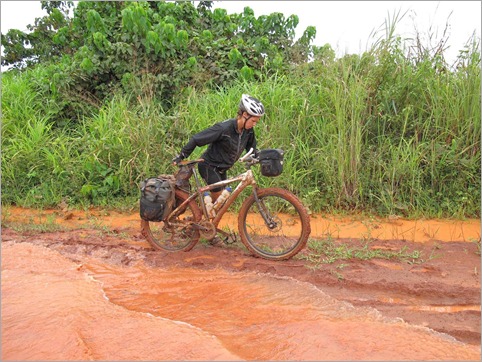
Fortunately Simon recovered quickly from his allergic reaction to an insect bite and we were able to set off early on the 15th, therefore only losing one day. It had rained the previous evening and I was worried that the first section of road in particular would be a repeat of the stint we had just completed. Our sponsors, DMC Mining had ensured our security for the journey to Brazzaville and so while I set off the boys went to the gendarmerie station to collect Richard, our armed security escort. Richard sat in the front seat all the way to Dolisie in military uniform with an AK47 slung over his shoulder. After about 20km, it was evident that my chain had suddenly worn out and Dan set to and changed it very efficiently. Roughly 10km further on the road condition improved due to the regular logging trucks which compacted the clay. I made pretty good progress on this surface but had to be alert to the huge trucks from a Malaysian logging company which frequently passed. I reached my minimum goal, Mossendjo (102km from Mayoko) by 3pm, the team checked in to the Commissariat, as was the protocol for this section of the journey, and then managed a further 26km to Tsimba. Again we checked in to the Commissariat and were able to stay there the night.
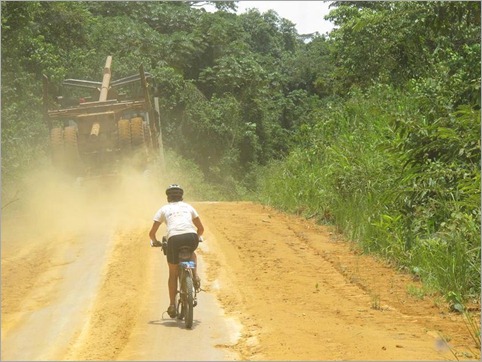
After Makabana we turned away from the old standard gauge railway line we had been following from Mbinda (border) towards the main road. The land opened out and the hills had gentler gradients. The main road which connects ROC to Gabon was a little better maintained, but corrugated and much busier. I was regularly enshrouded with clouds of dust from logging trucks in particular. It rained in the late afternoon which fixed that problem but made a mess of me. By the end of the day I’d managed to get within 25km of Dolisie, therefore covering the distance from Mayoko to Dolisie in two days rather than the three I had allowed for. Mind you, 130km and more than 8 hours of pedalling a day on these roads takes its toll. Our DMC friends put us up in Dolisie but because we stopped 25km before the town we had to drive back the next morning so I could continue the line. In Dolisie Richard left us and we were joined by Inspector Evariste, who travelled in plain clothes and with a concealed gun.
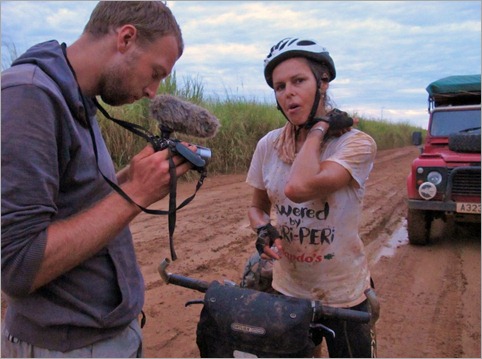
It rained heavily overnight and didn’t let up for most of the day. The roads were sodden and on the other side of Dolisie, (direction Brazzaville) the route was often submerged. So it was fun and games all day; another 8 ½ hours to cover 113km! I started off trying to go around the puddles, even through the bush, but the roadsides were usually deep clay where my feet sunk up to my mid-calf at times. It was usually much better for me and the bike to cycle through the water slowly. My brakes wore out in these conditions – it was essential to be able to control the bike down the steep, extremely rough slopes. Dan made more emergency repairs. Due to the conditions and more so for security reasons we needed to reach a town where we were safe, rather than camp. Therefore I had to slip and slide my way to the town of Nkayi, a small university town with welcome asphalt roads, by the beam of the Land Rover headlights. In the early evening I fell heavily, sliding off a high point between the tyre tracks. It was like skidding on ice. I landed on the same elbow I damaged back in Cameroon and grazed the scar off. It wasn’t so serious this time and Simon just washed it before I was back to work.
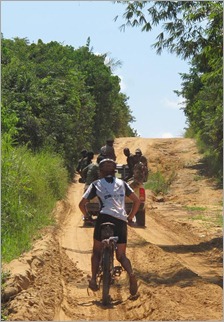 Dry conditions the next day allowed me to move more quickly and confidently, even if that meant being rattled to pieces. I seem to be able to average 15km an hour at best mostly due to the dried mud. In Cameroon they erected rain barriers to prevent vehicles destroying the road, and becoming stuck in wet conditions. Here there are no limits. Globules of mud formed from traffic in the wet set and form a surface which resembles degenerating cobblestones; an appalling, irregular surface to try to cycle. Staying upright and keeping the bike in one piece requires intense focus to be constantly planning the path a few metres in front of me. The scenery was superb when I did have a chance to enjoy it – I hadn’t imagined the Congo to be so beautiful (or such hard work). By the railway junction town of Loutete I had covered 85km and was psyched up for doing another 40km before dark. The Land Rover caught me just as I was through the town. I was about to enter the dangerous section of the road, controlled by the Ninja rebels. We had to stop in Loutete for the night. Evariste explained that we needed to consult the Army chief there to ask for his permission and personnel support to pass through the region. In fact for this section of the expedition we have been protected by all three security forces; military, gendarmerie, police. After cleaning ourselves up we visited the chief in the army barracks on a hilltop on the outskirts of Loutete. The chief gave us his full support and formed a plan for our protection.
Dry conditions the next day allowed me to move more quickly and confidently, even if that meant being rattled to pieces. I seem to be able to average 15km an hour at best mostly due to the dried mud. In Cameroon they erected rain barriers to prevent vehicles destroying the road, and becoming stuck in wet conditions. Here there are no limits. Globules of mud formed from traffic in the wet set and form a surface which resembles degenerating cobblestones; an appalling, irregular surface to try to cycle. Staying upright and keeping the bike in one piece requires intense focus to be constantly planning the path a few metres in front of me. The scenery was superb when I did have a chance to enjoy it – I hadn’t imagined the Congo to be so beautiful (or such hard work). By the railway junction town of Loutete I had covered 85km and was psyched up for doing another 40km before dark. The Land Rover caught me just as I was through the town. I was about to enter the dangerous section of the road, controlled by the Ninja rebels. We had to stop in Loutete for the night. Evariste explained that we needed to consult the Army chief there to ask for his permission and personnel support to pass through the region. In fact for this section of the expedition we have been protected by all three security forces; military, gendarmerie, police. After cleaning ourselves up we visited the chief in the army barracks on a hilltop on the outskirts of Loutete. The chief gave us his full support and formed a plan for our protection.
The Ninja rebels of today are the remnants of a militia which participated in numerous insurgencies and civil wars in 1990’s and early 2000’s. The militia was named after the ninja of feudal Japan. Their leader, Ntoumi has been described as a cult leader and a “messianic pastor”. In 2003, he informed a journalist that the Holy Spirit told him to form the Ninjas. Ninja militiamen wore the colour purple (symbolizing suffering), and had their hair in dreadlocks. After suffering defeats in the 1997-98 civil war, the Ninja retreated to the Pool Region (which we were about to enter). In 2003, Ninja leaders signed agreements with the government to cease hostilities in Pool. Despite of the peace accords, many Ninja militiamen remained active, and engaged in robberies of civilians and train hijackings. As of 2009, active Ninja remnants still exist in the southern Pool, but numbers are small. In June 2007, Ntoumi announced that the Ninjas were “going into constructive opposition” and were determined “to work for peace in Pool and across the country”. Ninja members led by Ntoumi burned around 100 of their weapons in a ceremony in Kinkala. Ntoumi was offered a government post in September 2007, but remained in hiding until December 2009, when he went to Brazzaville to take up the post. In describing the current position of the Ninja, our Inspector Evariste said that “we have cut off the head, but the fingers are still twitching!” The remaining fighters now have nothing to fight for and cause trouble because they know little else and have no other income. They “collect tolls” from travellers to support their lifestyle. Villagers help hide them from the authorities.
We set off early the following morning past the railway junction and out of town; the tarmac slowly degenerated and then I was back on the rough road. The first thing we all noticed was that the power pylons had all been destroyed – bombed so that they doubled over. After 15km we reached a village where the army was stationed. Evariste had to negotiate the price for two soldiers to join us for the 73km to Mindouli. The Land Rover was suddenly overcrowded. Dan and Zdenek were sandwiched in the back between the soldiers, with AK47 at the ready, who sat beside the windows. Basically I had to do the distance non-stop – no time for rest breaks, water or food refills. We were forbidden to take photos, particularly of the military. The scenery again was stunning, but there was no time to capture it. I had taken my bags off the bike to try and go faster, but still ended up with the same average speed because the road is too rough and with less weight, the ride is much more uncomfortable over this terrain.
The kids in the villages here greeted us with “Chinois” (Chinese) rather than referring to us as “le Blanc” (White person) as they usually did (We are referred to as “white man” or the equivalent in each language right across Africa). Rather than “bonjour” or “cava”, here they were shouting “ni hao” or “ni hao ma” (“hello” or “how are you?” in Chinese). The children here think that anyone who is not black African must be Chinese. The Chinese are the Congo’s biggest investor now. Even on this route Dolisie has a big Chinese construction business, Nkayi has a Chinese hotel (where we stayed) and hospital and Loutete has a Chinese cement works for example.
While I was busy cycling, Evariste was apparently on the phone every 15 minutes reporting our position to his colonel and that we were safe. It took roughly 5 hours to reach Mindouli which we did without incident. There we were greeted by the military and gendarmerie and taken to meet the army chief who was in control of the Pool region. After rushing down some lunch, I was preparing myself for the next section, a 63km, reportedly very bad and more dangerous section to Kinkala. I probably could have just made it by dark, but there was no guarantee and so they made the decision that we stay in Mindouli the night and be on the road first thing the next day. It was a bit frustrating because we had to waste half a day, but I fully understood the reason why.
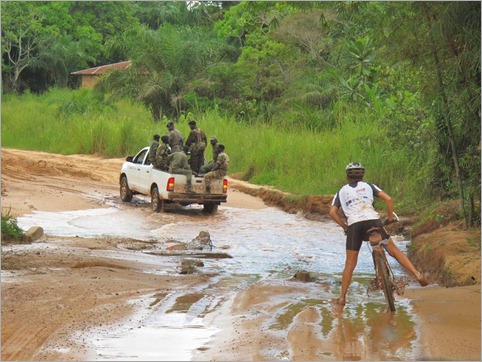
We were asked to be ready by 7am – which we were – but as usual we had to wait for almost an hour for the security to arrive. When Evariste received the message that they were coming, I set off ahead of them. Ten minutes later they caught me. I was expecting a couple of soldiers to be squashed in the Land Rover, but this time we were to be escorted by a utility with seven armed soldiers on the back. Suddenly I felt a little tense as the seriousness of their intent to protect us sunk in. It was very strange to be sandwiched between a ute full of soldiers, Kalashnikovs at the ready and the Land Rover. There has been a lot of recent activity in this section and the road was laced with rickety bridges and sections of bad mud and sand – all bottlenecks where vehicles would normally have to slow down. It had rained overnight, but not too much, so the worst sites were navigable. Two trucks in separate instances though had toppled over in the mud. Before the convoy had caught me out of town I was passed by a Spanish motorcyclist and a blue ‘roaring Corolla’ with the exhaust pipe poking out of the back door window. The army immediately stopped to chat to the people in the Corolla. They were a group of Ninjas including a known assassin according to Evariste. The army prevented them from travelling ahead so that they couldn’t forewarn their colleagues of our impending arrival. 13km on and the motorcyclist got stuck in the mud causing a bit of a traffic jam. I simply picked up my bike and found a pathway dry enough on the embankment to go around. Dan and the Ninja leader helped free the motorbike. I had to wait for a soldier to check that the path ahead was clear before I could set off as the others took some time to sort themselves out.
I had been watching my odometer closely as I was just about to click over the 10,000km mark. I managed to pull my little compact camera out of my barbag while on the move to take a sneaky photo to record my ten thousandth kilometre. Just as I did so there was a gunshot coming from the bush to my left. I jumped as the shot was fired and hence the resultant image is just a blur. At this stage I was about 50 metres behind the escort feeling rather vulnerable; the Land Rover about 100metres behind me. The soldiers then swung into action and two more shots were fired. I was waved forward almost straight away. “You’re kidding” I thought but did so hesitantly, stopping behind a mound of sand. I thought at least I would not be in the direct view of the Ninjas there. The captain then waved us through. Needless to say, my average speed for the second half of the journey to Kinkala increased! I will never forget the 10,000th kilometre of the BTC expedition.
The road surface turned sandy, so there was mud and sand to deal with. There were several cases where the soldiers stopped to check who was watching in the bush. We also passed Ninja check points, where if we had been travelling alone, they would have asked for a ‘toll’ to pass. For travellers like us it is likely that we could have passed through, but it may have been expensive. The Ninjas weren’t firing at us, they were attacking the soldiers. Africans who travel through the region are more at risk of physical attack because they may not be able to pay the fees. The government and combined security forces are winning though. Evariste mentioned that they have just captured a wanted assassin – he was very pleased with this news. To say that we were pleased to reach Kinkala after 60km non-stop is an understatement. Zdenek managed to snap a few photos, so please excuse that they were taken under difficult circumstances from the back seat of the Land Rover.
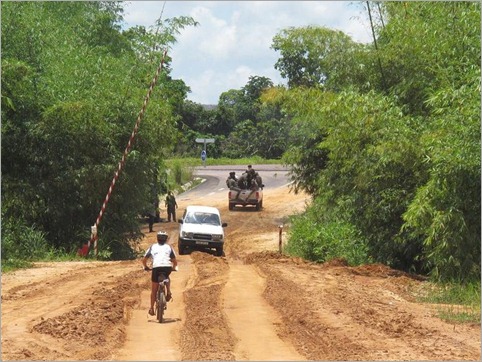
That was the first half of the day – now I just had to cycle 75km on smooth tarmac into Brazzaville. The Chinese have started building the road from Point Noir to Brazzaville. At the moment the main road between the two biggest cities has just a few kilometres of sealed road at either end. Most people either take the train or fly; few dare to drive! The river is also used for cargo. This makes transportation of commodities difficult, but once the road is through, this will make a huge difference to the development of infrastructure and businesses.
From the top of the hill at Makabana, 25km out I could see over Brazzaville, across the mighty Congo River to the high rise buildings of Kinshasa in the DRC. The outskirts of Brazzaville were a dusty, chaotic mess. Crossing a small bridge we were met by TV cameras and police ready to escort us through the city. Talk about going from one extreme to the other! Usually negotiating traffic in African cities is a hair-raising experience. I don’t know how many traffic jams we caused in the next 7km, but it was a pleasure to have a clear run and even see some of the town. Greeting us at the hotel was Henri Okemba, ex-minister and in charge of DMC in ROC and the press. The following afternoon I was a guest of the Minister for Mining, Mr Pierre Oba. The meeting was in the gazebo of his home on the Congo River waterfront where I received an official welcome; the discussion again filmed by the TV cameras for the evening news. Then it was canapés and champagne in the garden!
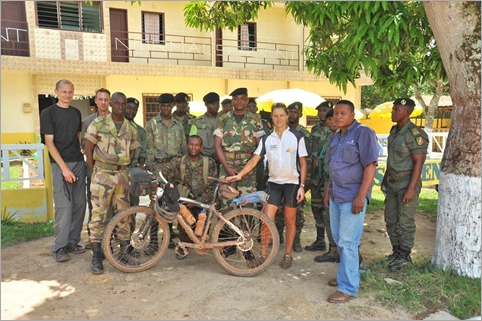
The team was invited as Mr Oba’s guests for dinner along with Mr Okemba and some other officials. The minister explained that the Republic of Congo has just received full debt relief. Due to many factors, the civil wars being the most tallying, the climate for investors has, in the recent past been poor. But times are changing. In 2006, the World Bank, International Monetary Fund (IMF), and the Paris Club group of official creditor countries approved interim debt relief for Congo under the Heavily Indebted Poor Countries (HIPC) Initiative, noting that Congo had performed satisfactorily on an IMF-supported reform program and developed an interim Poverty Reduction Strategy. Resources that are freed by interim debt relief granted to Congo are used for poverty reduction under a reform program closely monitored by the international financial institutions. And so for the Minister for Mines to proudly announce that his country has just been granted the thumbs up from the international community for national debt relief, this is a huge step for the ROC’s development and investment opportunities. It is proof that they have improved transparency immensely and with the country achieving peace the government is paving the way to attract investors and international business (such as DMC Mining). Our incident was really insignificant compared with where they have come from and proof that they are serious about wiping out the remaining handful of militants. In the 1990s and early 2000s, the ROC had been a place to avoid, but the debt relief means they have funds to rebuild and improve the quality of life of the four million people. There is definitely a way to go, but they have strong leadership who are building the foundations. The fact that a minister of the ROC government embraces what the BTC project stands for – the ideology and the action – really empowers me and ensures that the team starts off on the second half of the expedition on a high note.
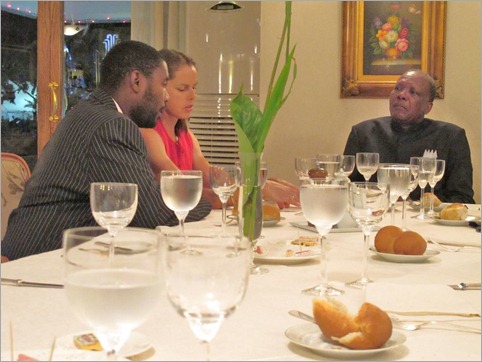
The team has been so well looked after in Brazzaville. Obtaining visas for Angola has been the biggest bureaucratic obstacle threatening the challenge of cycling across Africa from west to east in a continuous line. No travellers’ website lists anyone being successful in obtaining an Angolan visa to travel through the country from north to south. People can intermittently get 5 day transit visas which would be inappropriate for me as I need to cycle nearly 2000km through the country. Initially we came up against a brick wall, but thanks to the intervention and persistence from the Minister of Mines and our friends at DMC Mining, we’ve just collected 30 day visas. We are very excited to have the opportunity to travel through Angola, a country which most know nothing about – 27 years of civil war, landmines and blood diamonds are what most people will have heard about. Before Angola, we have to cross Congo River to Kinshasa, the massive capital of the Democratic Republic of Congo. We intend to take 3 days to traverse the state of Bas Congo before entering Angola.
Five months done; five months to go!



{ 5 comments… read them below or add one }
Hi Kate – what a time you have had and you are still looking wonderful. Can’t believe it has been 5 months. I am up visiting my mum for Easter and back on Tuesday. We are missing you so stay safe and healthy. Happy Easter!!
Love Lizziex
Hi Lizzie,
Great to hear from you. Yes, we are doing well here but still 10,500km to go and just over 4 months. All on track though. Before you know it I will be back! Love Kate
Hi Kate,
Al Cooke gave me your contact details.
If you are swinging by Tanzania please drop in for a cup of tea.
Our camp is yours if you need it. See our website.
We run a sustainable eco project 100km north of Dar es Salaam and we sponsor about 160 kids through school as well as a bunch of other conservation and development related projects.
We also have a mechanic, welders and a vehicle pit if you need.
Take care.
Rob
we are amazed at your trip you must be getting a great feeling of achiement in your self and partners keep being safe and the wheels turning.
Hi Rob,
Thank you for your kind offer in Tanzania. I’d love to meet you but unfortunately we won’t be travelling that way. I plan to cycle up the western side of the Rift Valley, through Mpanda, then to Burundi Rwanda, Uganda and across to Kenya that way. If anything changes, I will let you know.
Best regards,
Kate